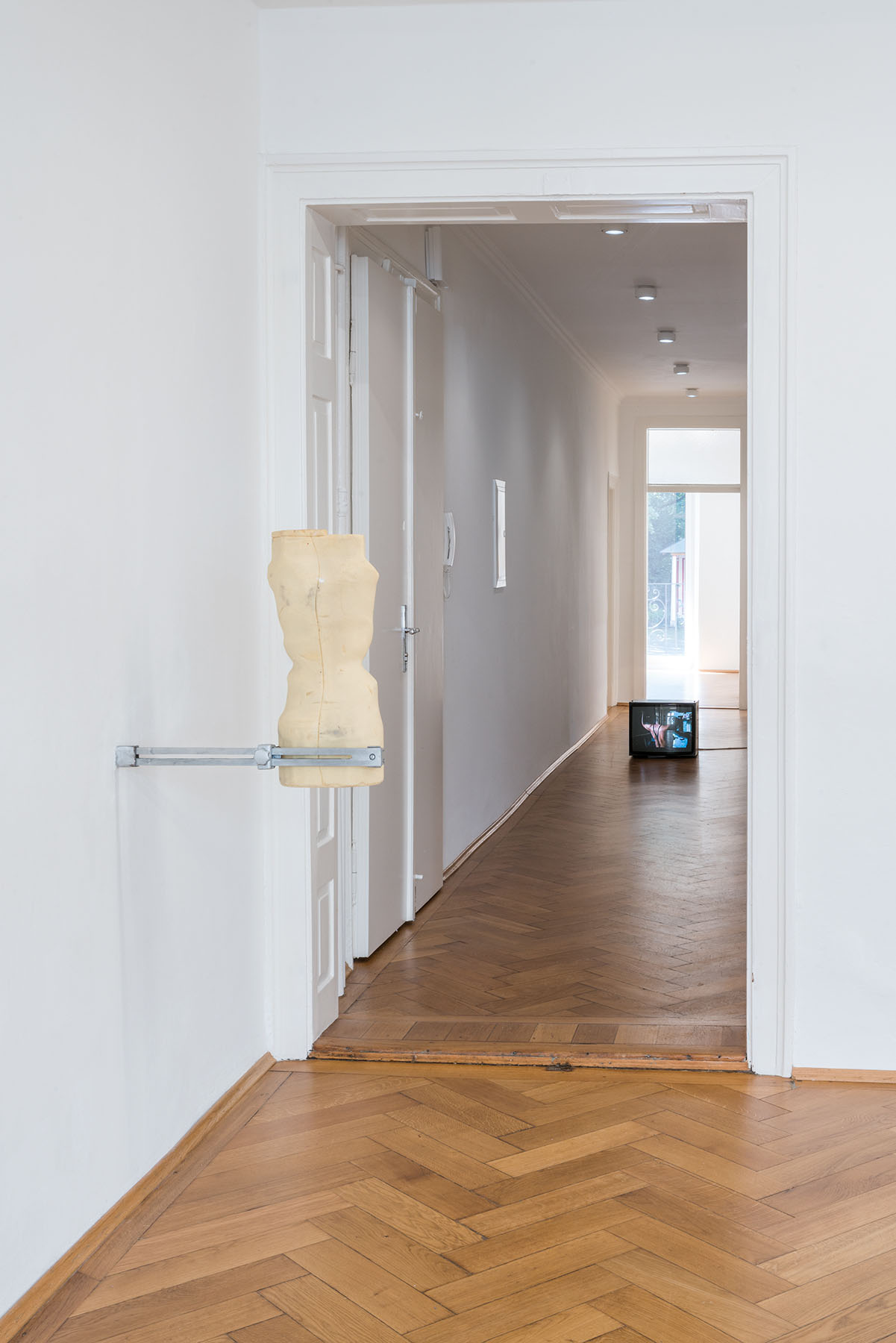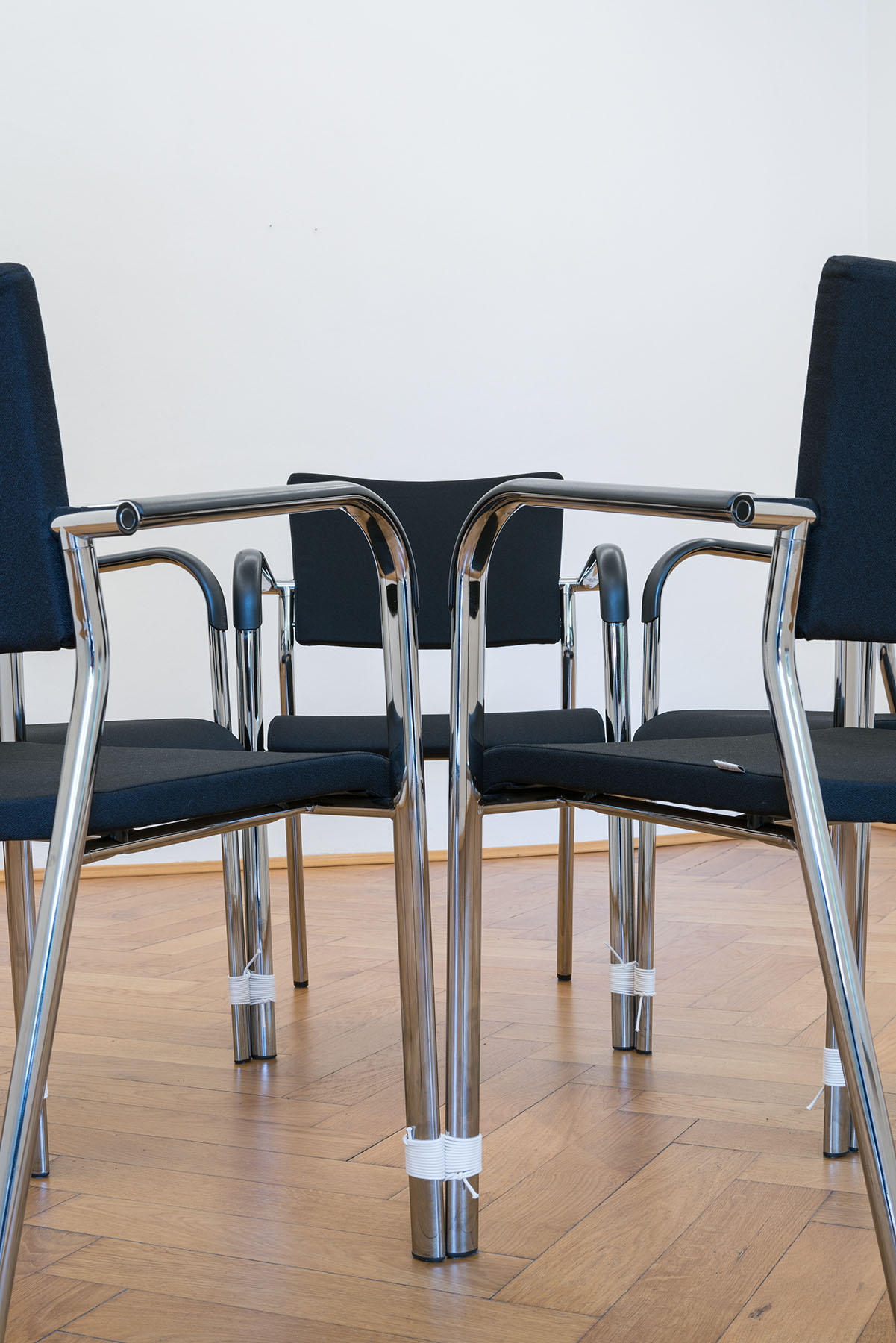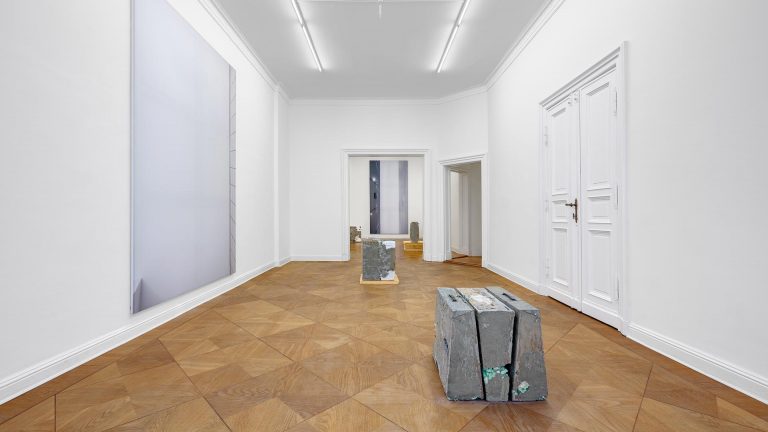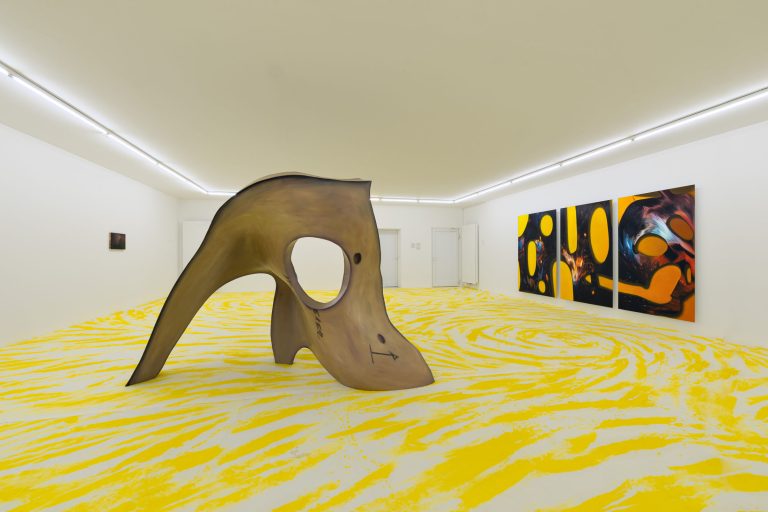Artists: Miguel Calderón, Karla Kaplun, Sarah Minter, Berenice Olmedo, Lucia Elena Průša
Exhibition title: The world is not like us, it was imposed, we try to transform it
Curated by: Anna Goetz
Venue: Galerie Britta von Rettberg, Munich, Germany
Date: September 11 – October 15, 2020
Photography: all images copyright and courtesy of the artist and Galerie Britta von Rettberg, Munich
“The world is not like us, it was imposed, we try to transform it” says a protagonist of Nadie es inocente [No One is Innocent] (1987) by Sarah Minter (1953–2016). The pioneer of Mexican video art and experimental film is known for her portraits of marginalized individuals and groups in Mexico. Her unsparing but empathic depictions are a critique of social inequality in Mexico, a persisting consequence of the country’s colonial history, the effects of which are still felt in Mexican society and the societies of other former colonies.
The group exhibition The world is not like us, it was imposed, we try to transform it deals with the violent imposition—and resistance against—Western constructs of identity, values, and development, which are defined as normative means by which hierarchies are constructed and reproduced, thus resulting in various forms of marginalization.
The exhibition presents drawings, sculptures, videos, photographs, and installations by five international artists of various generations, in which the body is used as a medium of resistance. The validity of patriarchal and modern concepts is called into question. The compulsion to adapt and subject oneself to these ideas is revealed as a process of physical and psychological violence. The bodies and their subjects struggle against these imposed patterns and ideals, bearing signs of the force used against them.
Nadie es inocente [No one is innocent] (1987) by Sarah Minter (1953–2016, Mexico City) offers a glimpse into the teenage lives of members of the punk band Mierdas Punk living in Nezahualcóyotl (an informal settlement of Mexico City). The docu-fiction is structured around Kara’s narration as he looks back and critically reflects on the daily experiences and visions of band members: described are struggles with a social system controlled by others and by which they are being marginalized. Neza (coll. for Nezahualcóyotl), where the teenagers live, is a prototype for an urban district whose development—due to a profound socio-economic shift—was unplanned: docked on to a large city it was only subsequently integrated into its infrastructure. Conditions within the informal settlement structure where the teenagers reside become an allegory for the social reality confronting them in their growing up. The teenagers’ history becomes a metaphor for the resistance against the values and modern notions of development and progress imposed on societies as desirable and through which social hierarchies are constructed and reproduced.
In Nadie es inocente – 20 años después [No one is innocent – 20 years later] (2010) (screening on October 8, 2020), Minter reconstructs the individual paths of the teenagers twenty years later, weaving together a new visual map of Neza and the life circumstances of her protagonists. They reflect on their accomplishments and frustrations in relationship to the hopes and dreams of their youth.
In Minueto [Minuet] (2010), Pablo “El Podrido” Hernández (protagonist of Nadie es inocente), now an adult, dances a ballet solo in his modest and cluttered living room. In Nadie es inocente – 20 años después he describes how he found his own way of expressing resistance through ballet.
Praying Arlequinos I, II, III (2020) von Karla Kaplun (b. 1993) is a continuation of the work series Acróbata Forze (since 2019). Her portrayals of bodybuilding figures blend references to the stylized bodies of post-revolutionary Mexican socialist realism with a European baroque theatricality. Ambiguous in nature, the bodies bring to mind harlequins—the literary figure that, in shunning the constraints of social norms and using this privileged position to express what others are denied, has never been a suitable vehicle for conveying the “correct” moral principles. Kaplun’s anarchic protagonists seem to defy this restrictive framework. This therefore becomes a metaphor for a system that judges subjects based on preordained categories or imposes these on them. At the root of this categorizing and compulsion toward assimilation is something deeply violent since social inequality is constructed and reproduced through this. Kaplun thematizes the body and its depiction as a means of resistance against conventional body images and classification based on socially constructed cultural, gender, or racial categories.
A compulsion to conform to norms and related social hierarchies is also a thematic focus of Berenice Olmedo’s (b. 1987) work héxis (2019), consisting of a readymade torso mold created to custom-fabricate medical corsets that correct the lateral (sideways) curves of the spine in scoliosis. The torso is here kept in position by cast anthropometric calibrators that usually serve to determine the degree of physical aberration from what is considered the norm. The torso represents the posture the deviant body is supposed to conform to in order to correct it. Olmedo uses medical technology as a medium for critically reflecting on discrimination and marginalization as symptoms of societal tendencies towards normalization. “Disability” is negotiated as a socially constructed category, comparable to gender or race. Olmedo thus addresses not only a physical problem, but a political topic—the conditions related to a form of being and the social constraints that created it.
Miguel Calderón (b. 1971) is regarded as a seminal figure in Mexico’s independent art scene during the 1990s—he was also co-founder of the influential, artist-run space La Panadería (Mexico City, 1994–2002). His multi-faceted work focuses on exploring power relations, in interpersonal (often family) relationships as well as between different groups in society. He draws satirical portraits—always with a respectful admiration for marginalized figures—depicting Mexico’s class society, defined by rigid hierarchies, which makes discrimination an omnipresent factor until today. The works presented in the exhibition negotiate these issues in an abstract, formal way: Marking Territory (1996) is an early photo series that is being shown here for the first time. It is a testimony to a youthful ritual among friends. The large-format photographs of hickeys express the inherently ambivalent nature of this form of play: under the guise of an adolescent game, this marking of the body conceals a violent display of power and dominance. Socavón [Sinkhole] (2020) montages iconic sequences from standard televised reports of sinkholes in Mexico City. Here, sinkholes are very common since the city was constructed on a lake depleted by Spanish colonizers; groundwater continues to be pumped out ever since, continuously eroding the ground. The collapsed surface exposes the underlying, corrupt infrastructure—a system that operates in the dark and serves to keep a social order “intact.” “Vivimos en el hoyo” [We live in the hole] is a colloquial phrase used by Chilangos (people living in Mexico City) to describe their city. It expresses the helplessness in the face of the corrupt and abstruse structure of the circumstances of the city.
Lucia Elena Průša (b.1985) presents the conceptual and site-specific installation 6. Know how to begin. (2020) consisting of five borrowed chairs forming a circle. This formal arrangement implies a democratic social structure whose subjects relate to one another in a non-hierarchical way. At the same time, a circle always defines a group determined by belonging and exclusion. Průša’s installation uses this formal structure to get visitors to position themselves in relation to the circle. For the conceptual work, Průša has borrowed chairs from a local counseling center for male* victims and perpetrators of psychological, physical, and sexualized forms of violence—domestic violence (relationship violence) and street violence. For the exhibition’s period of time (September 10 to October 15) she uses for 6. Know how to begin. five chairs from the MIM (Münchner Informationszentrum für Männer e.V.) – the only city-financed counseling and therapy center in Munich that works with male* victims and perpetrators. Průša thereby addresses the importance of such counseling organizations within society. She advocates critically for dealing proactively with acts of violence in families and relationships and the rehabilitation of and therapy for both victims and perpetrators. The act of violence is always an expression of a balancing out of power relations. It is symptomatic of structural problems in society, but is always based on an individual decision. Accordingly the task lies in the emancipation.
Text by Anna Goetz
Miguel Calderón (b. in 1971, lives and works in Mexico City)
Karla Kaplun (b. in 1993, lives and works in Mexico City)
Sarah Minter (1953-2016, lived and worked in Mexico City)
Berenice Olmedo (b. in 1987, lives and works in Mexico City)
Lucia Elena Průša (b. in 1985, lives and works in Vienna)
Anna Goetz is a curator and writer with a special interest in artistic strategies that challenge governing societal hierarchies, narratives, and structures. Currently, she is working between Frankfurt am Main, Germany, and Mexico City, researching on conceptual, collective, and participatory practices in Mexico during the 70s–80s.
Berenice Olmedo, from the series héxis, 2019, Installation view The world is not like us…, Britta Rettberg, 2020, Courtesy the artist, Lodos, Mexico City and Jan Kaps, Cologne, Photos: Christoph Grothgar
Berenice Olmedo, from the series héxis, 2019, Installation view The world is not like us…, Britta Rettberg, 2020, Courtesy the artist, Lodos, Mexico City and Jan Kaps, Cologne, Photos: Christoph Grothgar
Installation view The world is not like us…, Britta Rettberg, 2020, with works by Miguel Calderón and Berenice Olmedo, Photos: Christoph Grothgar
Installation view The world is not like us…, Britta Rettberg, 2020, with works by Miguel Calderón and Berenice Olmedo, Photos: Christoph Grothgar
Installation view The world is not like us…, Britta Rettberg, 2020, with works by Miguel Calderón and Berenice Olmedo, Photos: Christoph Grothgar
Miguel Calderón, Socavón (Sinkhole), 2020, Installation view The world is not like us…, Britta Rettberg, 2020, Courtesy of the artist and kurimanzutto, Mexico City, Photos: Christoph Grothgar
Miguel Calderón, Socavón (Sinkhole), 2020, Installation view The world is not like us…, Britta Rettberg, 2020, Courtesy of the artist and kurimanzutto, Mexico City, Photos: Christoph Grothgar
Miguel Calderón, Socavón (Sinkhole), 2020, Installation view The world is not like us…, Britta Rettberg, 2020, Courtesy of the artist and kurimanzutto, Mexico City, Photos: Christoph Grothgar
Miguel Calderón, Socavón (Sinkhole), 2020 Courtesy of the artist and kurimanzutto, Mexico City
Installation view The world is not like us…, Britta Rettberg, 2020, with works by Miguel Calderón and Sarah Minter, Photo: Christoph Grothgar
Sarah Minter, Nadie es inocente (No One Is Innocent), 1985-1987 Installation view The world is not like us… , Britta Rettberg, 2020 Courtesy Emiliano Rocha Minter, Photos: Christoph Grothgar
Sarah Minter, Nadie es inocente (No One Is Innocent), 1985-1987 Installation view The world is not like us… , Britta Rettberg, 2020 Courtesy Emiliano Rocha Minter, Photos: Christoph Grothgar
Sarah Minter, Nadie es inocente (No One Is Innocent), 1985-1987 Installation view The world is not like us… , Britta Rettberg, 2020 Courtesy Emiliano Rocha Minter, Photos: Christoph Grothgar
Sarah Minter, Nadie es inocente (No One Is Innocent), 1985-1987 Installation view The world is not like us… , Britta Rettberg, 2020 Courtesy Emiliano Rocha Minter, Photos: Christoph Grothgar
Sarah Minter, Nadie es inocente (No One Is Innocent), 1985-1987 Installation view The world is not like us… , Britta Rettberg, 2020 Courtesy Emiliano Rocha Minter, Photos: Christoph Grothgar
Sarah Minter, Nadie es inocente (No One Is Innocent), 1985-1987 Installation view The world is not like us… , Britta Rettberg, 2020 Courtesy Emiliano Rocha Minter, Photos: Christoph Grothgar
Installation view The world is not like us…, Britta Rettberg, 2020, with works by Berenice Olmedo and Miguel Calderón, Photos: Christoph Grothgar
Miguel Calderón, from the series Marking Territory, 1996 C-Print, 60 x 42cm, Courtesy of the artist and kurimanzutto, Mexico City
Installation view The world is not like us…, Britta Rettberg, 2020, with works by Berenice Olmedo and Sarah Minter, Photos: Christoph Grothgar
Installation view The world is not like us…, Britta Rettberg, 2020, with works by Berenice Olmedo and Sarah Minter, Photos: Christoph Grothgar
Sarah Minter, Minueto, 2010-2014, Installation view The world is not like us…, Britta Rettberg, 2020 Courtesy Emiliano Rocha Minter, Photos: Christoph Grothgar
Sarah Minter, Minueto, 2010-2014, video still, HD video in 16:9, color, 3 min. 30 sec., Courtesy Emiliano Rocha Minter
Installation view The world is not like us…, Britta Rettberg, 2020, with works by Berenice Olmedo, Sarah Minter, Karla Kaplun and Lucia Elena Průša, Photo: Christoph Grothgar
Installation view The world is not like us…, Britta Rettberg, 2020, with works by Karla Kaplun and Lucia Elena Průša, Photos: Christoph Grothgar
Lucia Elena Průša, 6. Know how to begin., 2020, Installation view The world is not like us…, Britta Rettberg, 2020, 5 chairs on loan from MIM (Munich Information Center for Men e.V.), 11.09. – 15.10.2020, Galerie Britta Rettberg, cotton cord, Courtesy the artist, Photos: Christoph Grothgar
Installation view The world is not like us…, Britta Rettberg, 2020, with works by Karla Kaplun and Lucia Elena Průša, Photos: Christoph Grothgar
Lucia Elena Průša, 6. Know how to begin., 2020, Installation view The world is not like us…, Britta Rettberg, 2020, 5 chairs on loan from MIM (Munich Information Center for Men e.V.), 11.09. – 15.10.2020, Galerie Britta Rettberg, cotton cord, Courtesy the artist, Photos: Christoph Grothgar
Lucia Elena Průša, 6. Know how to begin., 2020, Installation view The world is not like us…, Britta Rettberg, 2020, 5 chairs on loan from MIM (Munich Information Center for Men e.V.), 11.09. – 15.10.2020, Galerie Britta Rettberg, cotton cord, Courtesy the artist, Photos: Christoph Grothgar
Installation view The world is not like us…, Britta Rettberg, 2020, with works by Karla Kaplun and Lucia Elena Průša, Photos: Christoph Grothgar
Karla Kaplun, Praying Arlequinos I, II, III from the series Acróbata Forze, 2020 Installation view The world is not like us…, Britta Rettberg, 2020 Courtesy of the artist and Lodos, Mexico City, Photos: Christoph Grothgar
Karla Kaplun, Praying Arlequinos I, II, III from the series Acróbata Forze, 2020 Installation view The world is not like us…, Britta Rettberg, 2020 Courtesy of the artist and Lodos, Mexico City, Photos: Christoph Grothgar
Karla Kaplun, Praying Arlequinos I, II, III from the series Acróbata Forze, 2020 Installation view The world is not like us…, Britta Rettberg, 2020 Courtesy of the artist and Lodos, Mexico City, Photos: Christoph Grothgar






































